|
|
|
Sort Order |
|
|
|
Items / Page
|
|
|
|
|
|
|
| Srl | Item |
| 1 |
ID:
125110


|
|
|
|
|
| Publication |
2013.
|
| Summary/Abstract |
In recent years, a growing body of research has set out to examine the role that emotions play in shaping political attitudes and behaviors regarding terrorism. However, one major issue that is generally overlooked is whether the thematic relevance of emotive triggers leads to differential effects on people's reactions to international terrorism. Specifically, does anger-regardless of its source-tend to drive people towards supporting an aggressive foreign policy option to counter terrorism, or do the thematic underpinnings of anger (i.e., the specific contents that trigger this particular emotion, such as watching a news story about a recent terrorist attack) matter vis-à-vis the policy choice? To address this gap, this study experimentally examines the impact of anger-induced by thematically relevant versus irrelevant emotive triggers-on people's cognitive processing and foreign policy preferences regarding international terrorism. Overall, we find that the induction of anger via thematically relevant emotive triggers leads to a higher tendency for selecting a military option, a lower amount of information acquisition, and a shorter processing time in response to terror-related incidents.
|
|
|
|
|
|
|
|
|
|
|
|
|
|
|
|
| 2 |
ID:
125124
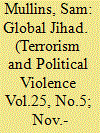

|
|
|
|
|
| Publication |
2013.
|
| Summary/Abstract |
This study aims to address the relative lack of research examining the Canadian experience of terrorism relating to the "Global Salafi Jihad." The fundamental research question was "What have people living in, or from, Canada been doing to support or advance violent jihad either at home or abroad?" Data were collected on individuals active from the 1980s through to the end of 2011 in an effort to be as exhaustive as possible. They were analysed according to three broad categories: background variables; operational variables; and investigations and outcomes. The sample was further divided into two and results compared according to whether individuals began offending before or after September 11, 2001, in order to assess change over time. The article begins with a brief history of terrorism in Canada, followed by the methodology, analysis of variables, and summary and conclusions. Cases included and excluded from the analysis are listed in Appendices A and B respectively.
|
|
|
|
|
|
|
|
|
|
|
|
|
|
|
|
| 3 |
ID:
125081
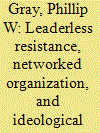

|
|
|
|
|
| Publication |
2013.
|
| Summary/Abstract |
This article examines various forms of "new terrorism," specifically the structure of "leaderless resistance," in connection with Robert Michels' idea of the "iron law of oligarchy." It is usually argued that "leaderless resistance" movements lack some of the typical obstacles of terrorist (and other) organizations, given their non-hierarchical and comparatively fluid natures. However, a new form of oligarchy develops in this type of movement, located in the propagation of key ideological concepts/arguments/symbols, the assigning of target preferences, and the elevation or demotion of others within the movement broadly. Rather than oligarchy forming via the material assets of organizations, an "ideational" oligarchy is created that shapes the goals of leaderless resistance movements: those leaders who are already established, and who control the means of communicating the movement's ideas to the widest audience, will impede the growth of groups and individuals within the movement that attempt to supplant their role. This article will use the examples of certain eco-terror groups (the Animal Liberation Front and the Earth Liberation Front) to explicate this development.
|
|
|
|
|
|
|
|
|
|
|
|
|
|
|
|
| 4 |
ID:
125141


|
|
|
|
|
| Publication |
2013.
|
| Summary/Abstract |
While fighting insurgency, both state and non-state groups depend on the local population for valuable resources such as food, intelligence, and security. By using a repertoire of subsistence coping mechanisms available to households in the context of the local political economy as an indicator of grievances and mechanisms of interactions between local households and the state and insurgents, district level data from Nepal on Maoist conflict is used to test hypotheses regarding state and insurgent violence. The analysis confirms that the state was more likely to kill people in a district where the number of households that borrowed to cope with subsistence was high. The Maoists were more likely to kill in a district with a higher number of subsistence sufficient households.
|
|
|
|
|
|
|
|
|
|
|
|
|
|
|
|
| 5 |
ID:
125083
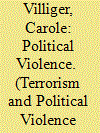

|
|
|
|
|
| Publication |
2013.
|
| Summary/Abstract |
When we speak of political violence during the second half of the twentieth century in Western Europe, we tend to think of events that took place in Germany, involving the Red Army Faction, and in Italy, with the Red Brigades. Such political violence does not apply in the case of Switzerland, which is perceived as a haven of peace, security, democracy, and economic affluence. However, cursory analysis of the contemporary press undermines this stereotypical vision: indeed, between 1968 and 1995 there were a number of violent acts of protest. Switzerland may not have experienced the phenomenon of organized armed struggle in the same way as Germany and Italy-in fact, the intensity of the violence was far from being the same-but political acts against the government did occur, acts involving either damage to property or, more rarely, injury to people. A rough typology identifies three different political tendencies: separatists and anti-separatists pertaining to Canton Jura, the far-Left, and the far-Right. The aim of this article is to pinpoint and analyze the different features of the violent repertoire that unfolded in Switzerland between 1968 and 1995.
|
|
|
|
|
|
|
|
|
|
|
|
|
|
|
|
| 6 |
ID:
125130
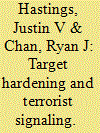

|
|
|
|
|
| Publication |
2013.
|
| Summary/Abstract |
In this article, we examine the relationship between hardening a target and the value that a terrorist group derives from attacking it. We use a simple expected value framework to compare how the expected value of attacking a hardened target varies between a violence-based approach, where terrorists are presumed to be maximizing the physical damage done to the target, and a signaling-based approach, where terrorists are presumed to be maximizing the symbolic value of their attack. We argue that, if it is proper to understand terrorist attacks as costly signals of terrorist strength or determination, hardening a target actually increases the expected value of attacking a target (relative to its value before hardening), even if the attack fails. We go on to examine the evolution of aviation security, and trace how al-Qaeda's views of airplanes and airports as targets have changed since 9/11. As aviation targets were hardened with increasingly onerous security measures, al-Qaeda began to see even attacks that did not result in detonation as successes, in large part because of what they signaled about al-Qaeda's abilities, and the ability of al-Qaeda to impose costs on the U.S. and other countries even in the absence of explosions.
|
|
|
|
|
|
|
|
|
|
|
|
|
|
|
|
| 7 |
ID:
125104


|
|
|
|
|
| Publication |
2013.
|
| Summary/Abstract |
The Provisional Irish Republican Army (PIRA), one of the best known and most researched terrorist organizations in history, has been comparatively assessed alongside various terrorist outfits from around the world. However, it has never been systematically compared with its most immediate rival, neighbour, and competitor, the lesser known Official Irish Republican Army (OIRA). This article addresses this scholarly gap and presents a thematic assessment of the similarities and differences between the two organisations in their respective post-ceasefire periods of 1972 and 1994. It proposes a new comparative approach to studying terrorist organisations in which knowledge about a better known entity (here, the PIRA) and its future trajectory is generated through a detailed assessment of the activities and developments of a not only more obscure case (here, the OIRA) but also, in many aspects, the most comparable case or cases. Such an approach could yield interesting results for the field of terrorism studies, which could still profit from in-depth, internal, case study analyses of specific terrorist organizations.
|
|
|
|
|
|
|
|
|
|
|
|
|
|
|
|
| 8 |
ID:
125135
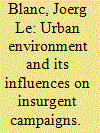

|
|
|
|
|
| Publication |
2013.
|
| Summary/Abstract |
For a long time, insurgency was a rural affair. The growing modernization of the modern world, however, shifts conflicts to the cities and requires us to explore the logics of armed struggle in urban environments. This article explores how the urban environment shapes armed conflicts, and argues that insurgents face severe practical constraints when acting in the cities. The urban environment offers the insurgents alternative ways of financing and of operating while close state control impedes them in pursuing a classic strategy of insurgency. Although state control cannot prevent attacks as such, it particularly hampers insurgents in relating to the population and organizing opposition. However, without massive and active support, armed struggle will remain sectarian and, thus, fail to achieve major political changes. This article argues that urban insurgents face a paradoxical relationship with society. While urban insurgents become independent of social support on an operational level, they depend more than ever on spontaneous massive and active social support on a strategic level.
|
|
|
|
|
|
|
|
|
|
|
|
|
|
|
|
|
|
|
|
|